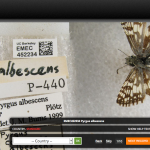Almost every morning since I moved to Santa Cruz, I’ve seen their long, brown-and-yellow bodies slither across my counter tops. My unwanted house guests are cellar slugs and I imagine that their shimmering slime trails are chock-full of germs, ready to infect me.

The cellar slug, Limacus flavus, is active at night. Scientists say it is fond of pet food. Photo: Ryder Diaz
Like most people, I strive for sterility from the outdoors. But could this obsession with cleanliness be harming us?
Some microbiologists are looking at how architecture shapes the types of mircoorganisms we come in contact with and what that means for human health. They’re finding that sometimes cleanliness isn’t always the healthiest.
A group of researchers from the University of Oregon turned to hospitals, those structures touted as fortresses against bacteria, to understand what happens when we try to keep germs out.
The team’s methods were simple. It measured the number of different types of bacteria in a typical air-conditioned hospital room, outside of the building and in a hospital room where the windows were opened allowing outdoor air to flow through.
The researchers discovered that when the windows were closed and the air conditioner blared, there were few different types of bacteria in the hospital room. This is what scientists call low diversity.
When the breeze was allowed to waft in naturally, more types of bacteria were in the air – a higher diversity.
Not surprisingly, they found greatest diversity outside, where bacteria live in soil and on plants.
Are fewer types of bacteria in the hospital room good news for germaphobes? Not necessarily.
The team found that if you randomly picked out one bacterium from the air in the air-conditioned room, you were more likely to grab a potential pathogen than if you plucked a random bacterium from the air outside.
With the windows open, your chance of choosing a potentially dangerous bacterium was somewhere in between.
In other words, in the sealed up hospital room, fewer types of bacteria could come to the party, but you wouldn’t want to hang out with any of them. The team suspects that the architecture of hospitals is keeping all the bad stuff in.
This conclusion may seem common sense, but have you ever tried to open a window in a hospital? It’s impossible.
It’s fun to think about how research like this might change modern architecture and design. Designers of passive architecture have turned away from air conditioning and looked toward how strategically placed windows and vents can cool a building and save energy. Could these designs also foster a microbe-friendly space?
First, scientists are trying to figure out the array of microbial life living among us: in our homes, workplaces, and public spaces. The next step is figuring out what they all do.
Back at my apartment, I watch a large slug as it encircles the drain of my kitchen sink. Normally, I’d pick it up and toss it out the front door. But today, I let it be. Perhaps I need it more than I know.








The bacteria in slug slime are (1) slug bacteria, which won’t hurt you but might stimulate your immune system and (2) whatever bacteria normally live on the surface the slime trail is on (your sink), which won’t hurt you any more than they would without the slug slime.
But slugs are lovely elegant creatures, so just put them outside.